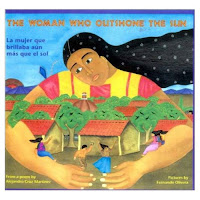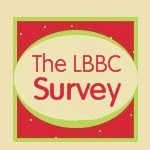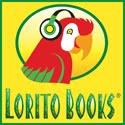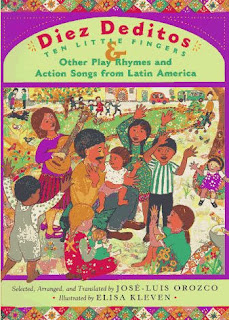Wednesday, March 25, 2009
Chicago Latino Book & Family Festival
The featured authors in Chicago include personalities like Raul de Molina ("La Dieta del Gordo"), Maria Marín ("Mujer sin Límite"), Susan Orosco ("Latino Power"), and Xavier Serbia.
The event is free to the public and takes place at the Unity School in Cicero, IL. Doors are open from 12 p.m. to 8 p.m. on Saturday and from 11 a.m. to 6:00 p.m. on Sunday.
Leer es Poder is one of their key messages. What a powerful thing to learn at any age.
Monday, March 23, 2009
LinaLuna- musica for the wide green world

I wish I could say that we listen to Spanish language music in the car, but- thanks to the backseat dvd player- when we're driving somewhere as a family, what's mostly playing is an animated movie or a dvd of Plaza Sesamo. Where we do listen to Spanish language music frequently is at home. Specifically, we have dance parties in the kitchen and great room, sing and dance while we cook, and, once the weather's nice, leave the door open and enjoy music outside from the jardin or terraza.
Friday, March 20, 2009
I'm Just Like My Mom Giveaway

Last August, Aurora interviewed Jorge Ramos on his new bilingual children's book, Me Parezco Tanto a Mi Mamá, Me Parezco Tanto a Mi Papá. The interview includes a variety of questions on the inspiration behind the book, as well as more personal questions about Mr. Ramos' life.
This week, Spanglish Baby has posted a new interview with Jorge in which he discusses his views on bilingualism and Spanglish. They are also giving away a free autographed copy of the book! So what are you waiting for? Andale - go check it out here!
Wednesday, March 18, 2009
The Woman Who Outshone the Sun

This book is useful and enjoyed by my bilingual students. Both English and Spanish text are on each page, accommodating independent or shared reading. Recently, I had the pleasure of inviting my father to my classroom as a guest reader. He read this book to my students, and was struck by its beauty.
Tuesday, March 17, 2009
Book Drive Update
Sunday, March 15, 2009
Poemas con sol y son
 My mother read to my brother and me every day when we were little, but I don’t remember her reading to us much in Spanish. We lived in the U.S. back then, and children’s books in Spanish were probably hard to come by. Whatever the reason, she read to us mainly in English.
My mother read to my brother and me every day when we were little, but I don’t remember her reading to us much in Spanish. We lived in the U.S. back then, and children’s books in Spanish were probably hard to come by. Whatever the reason, she read to us mainly in English.This I do remember: When she did read to us in Spanish, she read poetry. I don’t remember more than a handful of the poems themselves, but I can still hear the rhyming verse, the soothing lilt of my mother’s voice, and vividly recall the cozy bedroom where we read at night. Many years later, when I was in high school, my mother gave those books away. She donated them to the local school in our town in Costa Rica, a tiny, rural school that was desperately in need of books. I was crushed. It felt like a cherished part of my childhood had been lost.
It’s strange, then, that I didn’t rediscover children’s poetry until my twins were two. When I happened upon that first book of poetry, I soon began calling it my “magical book.” Whenever I pulled it out, tantrums miraculously stopped, crying fits were quelled, replaced with giggles and cries of, “¡Otra vez! Otra vez!” (I felt a special kind of mother’s guilt as I left my children’s bedroom one night while one of them cried repeatedly, fat tears rolling down his cheeks and book of poetry in hand, “¡Quiero más poesías!”—even though it was way past his bedtime and I suspected I was being manipulated.)
Though other books have been outgrown or fallen out of favor, our books of poetry are here to stay. We now own no fewer than twenty of them (because once you start, you can’t stop). But even though they’re all fun books, only a few of them qualify as magical.
One of them is Poemas con sol y son, a book I love for many reasons. I’m partial to anthologies, and this one includes poems by various authors from thirteen countries. The book is divided into sections, one section per country, and the name of the country is printed on each page.
In this book you will find poems by Rubén Darío and Gabriela Mistral—but only a couple of them. (I’d only heard of a few of the authors before, so I liked the short bios at the end of the book.) There’s a little of everything, and it makes for a great mix. Some of the poems are wistful, like the one about the little boy following the moon, or the one about the abuela who tells her grandchild stories of her childhood and then begins to weep. Some are fun, or just plain silly—there’s a message for Jonah (from the whale, of course), a poem that explains why penguins wear coats and tails instead of blue jeans, and a sweet conversation between a ladybug and a snail in the spring. Some of the poems you can practically dance to.
My boys were two when we discovered this book, but it would be appropriate for children many years older as well. This book will grow with them--the vocabulary is deliciously rich and some of it is obviously over my preschoolers’ heads (and often over my head as well). I love that they will be exposed to such beautiful language, language that I can’t just come up with on my own. I read to my children in Spanish because I realize it’s such a valuable teaching tool, and because I want learning Spanish to be fun, not a chore. This book makes it easy. I’ll admit that my favorite poems are the ones that take words and play with them, shape them until they’re sometimes barely recognizable but the meaning is still clear. Take this excerpt from Palabrota, by Argentinean author Silvia Schujer:
Una palabra
palabritera
despalabrábase
por la escalera.
¡Pobre palabra!
se apalabró
palabrincando
cada escalón.
Or this excerpt from La bicicleta, by Eugenio Montejo of Venezuela:
La bici sigue la cleta
por una ave siempre nida
y una trom suena su peta…
¡Qué canción tan perseguida!
Some of the poems provide food for thought—did you ever stop to think that maybe the H is silent because she was tired and fell asleep? And then there’s my favorite poem, which is also the shortest one in the book, by Colombian poet Jairo Aníbal Niño. The title asks, ¿Qué es el gato? and the answer reads, simply:
El gato
es una gota
de tigre.
My only regret is that I didn’t buy the hardcover edition, because we’ve been so hard on our paperback that it’s held together with tape. Still, I’ll never get rid of it. My kids may want it someday.
Friday, March 13, 2009
Pon, pon: A jugar con el bebé!
 I love going back home for a lot of the obvious reasons, but also because, as an avid reader, it gives me a chance to stock up on books in Spanish. Now that I'm a mami, I've added children's books to my list. The selection tends to be much more varied than back in the States--especially now that we live in Colorado! I know there's always the option of getting books online, but there's nothing better--for me, at least--than to spend time browsing a bookstore, just picking up whatever looks interesting.
I love going back home for a lot of the obvious reasons, but also because, as an avid reader, it gives me a chance to stock up on books in Spanish. Now that I'm a mami, I've added children's books to my list. The selection tends to be much more varied than back in the States--especially now that we live in Colorado! I know there's always the option of getting books online, but there's nothing better--for me, at least--than to spend time browsing a bookstore, just picking up whatever looks interesting. I should clarify that by "home" I usually mean Perú because even though I left many years ago, I still feel like that's the one place that will always pull me more than any other. Having said that and because my extended family and mis suegros y cuñada live in other Latin American countries, my search for books in Spanish is not limited to Perú. I have the fortune to visit Puerto Rico at least once a year and Mexico every two years.
It was actually during our last trip to La Isla del Encanto this past Christmas where I found the most wonderful collection of children's books which I immediately purchased for my daughter, Vanessa (and for myself, too!). The series is called "Colección 9 Pececitos" and it includes five books full of colorful illustrations with titles such as Los Tres Reyes, Pon, pon: A jugar con el bebé! and ¡Vamos a Jugar! All the books are supposed to be suitable for kids in their preschool years all the way to tweens. And, although my daughter might still be too young for some of them, she will eventually grow and be able to understand and appreciate them. So, it was totally worth the buy!
Vanessa loves to sing and it warms my heart to hear her tiny voice, especially when she sings tunes that take me back to when I was a child. It is so important for us to pass on all the traditional songs, nursery rhymes and finger plays both her father and I grew up with which is one of the reasons I enjoy Pon, pon: A jugar con el bebé! so much. The book, written by Josefina Barceló Jiménez and illustrated by Mrinali Alvarez Astacio, is described as reflecting la cultura puertorriqueña. But the reality is that although the wording might be different, I bet most of us--no matter which Latin American country we hail from--have heard a version of most of these songs. Check them out for yourselves:
Pon, pon
(Sing this while taping your index finger on the palm of your hand)
Pon, pon, nena pon
el dedito en el pilón.
(Sing this while clapping your hands softly)
La Linda Manita
Tortitas, tortitas, tortitas de manteca
a mamá que de galletas.
Tortitas, tortitas, tortitas de tostones
a papá que da calzones.
Tortitas, tortitas, tortitas de casabe
a mi hermano que no lo sabe.
Tortitas, tortitas, tortitas de pan y queso
a abuelita que me da un beso.(Sing this while waving with your hand)
La linda manita
que tiene el bebé
qué linda, qué mona,
qué graciosa es.
My daughter's face lit up when I opened up the book and I started singing this last song for her. She had been to Puerto Rico before and had heard her cousins, grandparents and aunts sing it to her, so it was a moment of remembrance and recognition. We hadn't sung it in a while, maybe because she's a little older now, but the fact that her vocabulary grows exponentially every single day, allowed her to sing along which made the whole experience even more enjoyable.
All of these songs and finger plays are part of our cultural heritage. Raising bilingual children is more than just teaching them Spanish. It's about our music, our foods, our traditions and our holidays--among other things. We are committed to making this a reality and invite you to join us at SpanglishBaby as we explore these aspects and all others of this fantastic and sometimes challenging journey of raising our children to become bilingual and bicultural.
Wednesday, March 11, 2009
René Colato Laínez- New Contributor

Hola Latin Baby Book Club Friends,
I am excited to be part of this great blog. My name is René Colato Laínez and I am a children's book author. Every month, I will bring new bilingual titles, interviews, poems y muchas cosas más.
My childhood heroes were Cri Crí-el gallito Cantor and El Chapulín Colorado.
¿Quién es el que anda aquí?
Es Cri Crí, es Cri Crí
-¡Oh! ¿Y ahora quién podrá ayudarme?
-¡Yo, el Chapulín Colorado!
My favorite favorite book is Don Quijote de la Mancha. I still remember the first line of the book:
En un lugar de la Mancha, de cuyo nombre no quiero acordarme...
But I will always recordar this blog. Look for my contributions the second week of every month.
Saludos,
René Colato Laínez
Saturday, March 7, 2009
March BOM: José-Luis Orozco's Diez Deditos
& Other Play Rhymes and Action Songs from Latin America
By José-Luis Orozco
Illustrated by Elisa Kleven
The LBBC’s recommendation for February’s Libro del Mes, is José-Luis Orozco’s Diez Deditos.
Esta es me mamá.
Este altito es mi papá.
Esta es me hermana.
Y este(a) chiquito(a) y bonito(a) soy yo."
Uno le canta,
Otro le pía.
Y tres le tocan la sinfonía."
Parents and teachers cannot possibly go wrong with this book. It is certainly a must have for any bilingual family’s library.
If you would like to buy your own copy of Diez Deditos, please click here. Or you can follow the link in our sidebar to the LBBC’s on-line store. We have both new and gently used copies available.
Wednesday, March 4, 2009
Fun with Songs, Rhymes, and Games
Parents can make these activities a part of their daily routines even if they don't feel comfortable reading. If a mother remembers the songs that her mother sang, for example, singing those songs to her child is a wonderful way to continue a family tradition, and to expose the child to language and rhyme.
Colorin Colorado has compiled a number of our articles that offer an overview of some of these activities in our new section, Getting Ready to Read: Family Activities. The articles are available in English and Spanish, and include many ideas that parents can start using at home right away.
Also, be sure to take a look at our Meet the Author section, and the clips from our new video interview with Lulu Delacre, an acclaimed Latina author and illustrator who has published numerous children's books. In these video clips (also available in Spanish), Lulu discusses the ways that songs and games can help build early literacy skills (a great feature for parent literacy workshops!).
She also describes the inspiration behind her beloved characters, Rafi and Rosi, and reads aloud from Rafi and Rosi: Carnival! And don't miss the clips where she discusses how she got started publishing collections of Latin American nursery rhymes, and the importance of maintaining connections to one's heritage - another great segment to use in parent discussions about reading! (The full interview will be available online in the spring.)
Monday, March 2, 2009
The LBBC and Peruvian Hearts' Library Project
 Ana Dodson is an amazing and inspiring young woman.
Ana Dodson is an amazing and inspiring young woman.Born in Cuzco, Peru, Ana was adopted as a baby and brought to America. In 2003, she and her mother decided to return to Peru for a visit. Before leaving, she collected books in Spanish and teddy bears to take to a few of the orphanages that they had planned to visit. One in particular, The Hogar Mercedes de Jesus Molina, deeply touched Ana. And her visit there prompted her to establish Peruvian Hearts, a non-profit organization dedicated to enhancing the lives of children living in poverty in Peru through nutrition, education and healthcare.
She was only 11 years old.
Today, Peruvian Hearts has successfully implemented a number of improvements and programs to help both the children at the Hogar and in other Peruvian towns. Their goal is to make the Hogar a model for other orphanages. Ana and her organization are making or have already made a lot of improvements to the orphanage building, such as starting construction of a new dining room and modern kitchen, a covered laundry area, and the completion of modern bathrooms so that the girls no longer have to share one outdoor shower.
Peruvian Hearts also raised enough money this past year for their Education Fund, which they used to send all 19 girls at the Hogar to local Catholic schools in order to provide them with the opportunity to go to college, if they so choose.
For a complete list of Peruvian Hearts programs, check out their web site here.
To me, this is an amazing and inspiring young woman and family. And so, to support Ana Dodson in the pursuit of her dreams, the LBBC for the next 6 weeks will be hosting a small book drive for Peruvian Hearts. The books will be part of their Library Project. So between now and April 12th, we ask all of our wonderful readers to please consider donating a new or very gently used children’s book in Spanish. Bilingual books will be accepted; however, they must contain FULL TEXT in Spanish (and English.) Spanish-only books are preferred, though, for obvious reasons.
To reduce the cost, you can mail your book donation as "media mail" from your local post office. Please address your donation to:
Peruvian Hearts - LBBC Book Drive
24918 Genesee Trail Road
Golden, CO 80401
 We know that globally, these are hard economic times, and because of this many non-profits around the country are suffering. We’ve chosen Peruvian Hearts for a couple of reasons: Ana Dodson’s selflessness and compassion at such a young age, and to support this young Latina who is trying to improve the lives of other young Latinos in a country suffering much worse poverty than ours – and succeeding. In addition, one book is a small, relatively inexpensive donation, whose value may be powerful and life-changing.
We know that globally, these are hard economic times, and because of this many non-profits around the country are suffering. We’ve chosen Peruvian Hearts for a couple of reasons: Ana Dodson’s selflessness and compassion at such a young age, and to support this young Latina who is trying to improve the lives of other young Latinos in a country suffering much worse poverty than ours – and succeeding. In addition, one book is a small, relatively inexpensive donation, whose value may be powerful and life-changing. Por favor, consider helping a child through your simple gift.
Sunday, March 1, 2009
Entra a Mi Mundo: A Gift for Mothers and Their Babies
You can use the book by simply flipping through it and picking out activities, but for those mamis who like a little more structure, it is divided into months with a supplies list at the beginning of each and a space for writing down notes at the end. Told from the perspective of a child, each month contains one activity per day that will help him or her discover the world around him and/or develop her inner creativity.
For example, August 4th says…
Let’s make an Emotion Mobile. Draw or cut out faces
The authors, Lina Maria Cuartas and Annabel Lugo Hoffman, both have extensive experience with teaching children. Cuartas, who is also the book’s illustrator, is a devoted advocate for underprivileged children, and has taught young children in the U.S., Colombia and in remote villages across the Amazon rainforest. Her first activity book for school-age children, Crezcamos Juntos! (Come Grow With Me!) sold over 25,000 copies in Colombia. Co-author and attorney, Hoffman is also a trained volunteer promoting early literacy for young children. She speaks to audiences throughout the Dallas, TX area about how to prepare children for school.
Regocíjate en la certeza de que cuando estoy jugando,
This book is certainly an asset to any family looking for ideas on how to connect with their children and develop their senses of curiosity and exploration.
To learn more about this book and other products by Lunita Company, you can check out their web site here
















